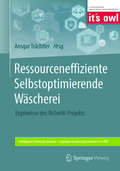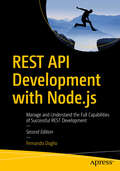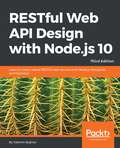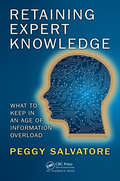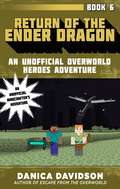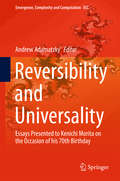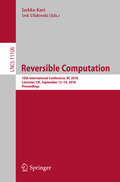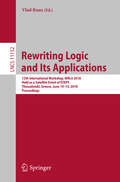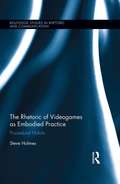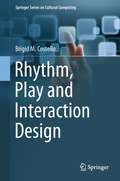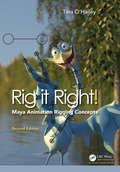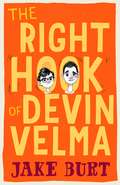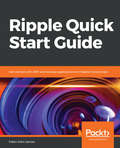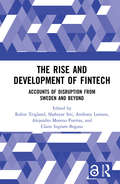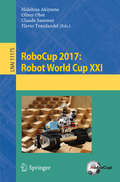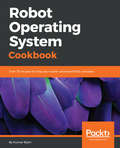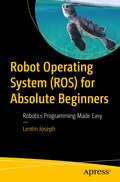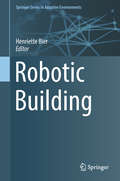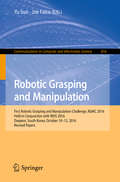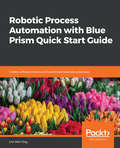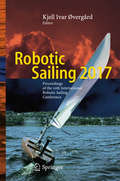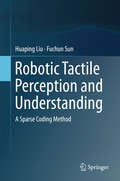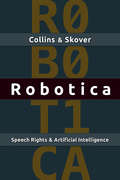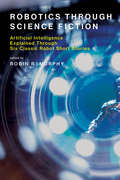- Table View
- List View
Ressourceneffiziente Selbstoptimierende Wäscherei: Ergebnisse des ReSerW-Projekts (Intelligente Technische Systeme – Lösungen aus dem Spitzencluster it’s OWL)
by Ansgar TrächtlerDie Publikation befasst sich mit der Optimierung einer Wäscherei hinsichtlich ihrer Ressourceneffizienz. Ressourcen umschließen hierbei die menschliche Arbeitskraft, der Umsatz von Chemikalien und Wasser, sowie den Energieverbrauch. Die Grundlagen der Wäschereitechnik und die eingesetzten wissenschaftlichen Methoden bilden die Grundlage für die exemplarische Umsetzung einer ressourceneffizienten Wäscherei. Diese Umsetzung erfolgt in vier Pilotprojekten, die sich mit unterschiedlichen aktuellen Herausforderungen der Wäschereitechnik beschäftigten.Ergebnisse des ReSerW-Projekts im Rahmen des Spitzenclusters intelligente technische Systeme OWL (it’s OWL).
REST API Development with Node.js: Manage and Understand the Full Capabilities of Successful REST Development
by Fernando DoglioManage and understand the full capabilities of successful REST development. REST API development is a hot topic in the programming world, but not many resources exist for developers to really understand how you can leverage the advantages.This completely updated second edition provides a brief background on REST and the tools it provides (well known and not so well known), then explains how there is more to REST than just JSON and URLs. You will learn about the maintained modules currently available in the npm community, including Express, Restify, Vatican, and Swagger. Finally you will code an example API from start to finish, using a subset of the tools covered.The Node community is currently flooded with modules; some of them are published once and never updated again - cluttering the entire universe of packages. Pro REST API Development with Node.js shines light into that black hole of modules for the developers trying to create an API. Understand REST API development with Node.js using this book today. What You'll LearnUnderstand how REST and API development mix up with Node.jsCreate a scalable, technology agnostic, and uniform interfacePrepare your services to be consumed by your clientsTest and deploy your APIReview troubleshooting techniques Who This Book Is ForAny Node.js developer who wants to fully understand REST API development. Beginner and Intermediate Node.js developers who are looking to fully understand how to create RESTful microservices.
RESTful Web API Design with Node.js 10, Third Edition: Learn to create robust RESTful web services with Node.js, MongoDB, and Express.js, 3rd Edition
by Valentin BojinovDesign and implement scalable and maintainable RESTful solutions with Node.js 10Key FeaturesCreate rich and scalable RESTful API solutions from scratchExplore the new features of Node.js 10, Express 4.0, and MongoDBIntegrate MongoDB in your Node.js application to store and secure your dataBook DescriptionWhen building RESTful services, it is really important to choose the right framework. Node.js, with its asynchronous, event-driven architecture, is exactly the right choice for building RESTful APIs.This third edition of RESTful Web API Design with Node.js 10 will teach you to create scalable and rich RESTful applications based on the Node.js platform. You will be introduced to the latest NPM package handler and understand how to use it to customize your RESTful development process. You will begin by understanding the key principle that makes an HTTP application a RESTful-enabled application. After writing a simple HTTP request handler, you will create and test Node.js modules using automated tests and mock objects; explore using the NoSQL database, MongoDB, to store data; and get to grips with using self-descriptive URLs. You’ll learn to set accurate HTTP status codes along with understanding how to keep your applications backward-compatible. Also, while implementing a full-fledged RESTful service, you will use Swagger to document the API and implement automation tests for a REST-enabled endpoint with Mocha. Lastly, you will explore some authentication techniques to secure your application. What you will learn Install, develop, and test your own Node.js user modulesUnderstand the differences between HTTP and RESTful applicationsUse self-descriptive URLs and set accurate HTTP status codesEliminate third-party dependencies in your tests with mockingImplement automation tests for a REST-enabled endpoint with MochaSecure your services with NoSQL database integration within Node.js applications Integrate a simple frontend using JavaScript libraries available on a CDN serverWho this book is forIf you are a web developer keen to enrich your development skills to create server-side RESTful applications based on the Node.js platform, this book is for you. Some knowledge of REST would be an added advantage, but is definitely not a necessity.
RESTful Web API Design with Node.js 10 - Third Edition.: Learn To Create Robust Restful Web Services With Node.js, Mongodb, And Express.js
by Valentin BojinovRESTful services have become the standard data feed providers for social services, news feeds, and mobiles. If you want to build fast REST APIs and want to deliver a large amount of data to millions of users, you'll find this book extremely useful. This book will teach you to create scalable RESTful applications based on the Node.js platform.
Retaining Expert Knowledge: What to Keep in an Age of Information Overload
by Peggy SalvatoreRetaining Expert Knowledge is a training resource, but it is also a business resource. As knowledge proliferates and organizational culture rapidly changes, now is the time to step back and determine what has been important to your organization’s success, where the organization is today, and what it will take to stay in the game tomorrow. Your company houses knowledge, skills, attitudes, intellectual property, trade secrets, company culture, and individuals who will never be replicated exactly as they are today. <P><P>Because they have demonstrated value in the past and are demonstrating value today, these treasures are worth preserving. This book shows how to preserve these valuable assets today for tomorrow’s successes.
Return of the Ender Dragon: An Unofficial Overworld Heroes Adventure, Book Six (An Unofficial Overworld Heroes Adventure #6)
by Danica DavidsonAfter dangerous adventures all over the Overworld and in Earth, Stevie, Alex, and Maison have managed to reassemble the mysterious Ender crystal—but they were too late! The Ender Dragon has escaped her prison in the End, and she’s tormenting the Overworld with Ender crystals of her own, and an army of terrifying monsters.When the Ender Dragon threatens to travel to Earth as well, the friends have to take a stand. Can they wrest the Ender crystals away from the dragon, and defeat her evil minions, in time for a final showdown against the great dragon herself? And will any of them survive the battle to defend the worlds they love?Fans of Minecraft will be on the edge of their seats in this thrilling final installment in the Unofficial Overworld Heroes Adventure series!
Reversibility and Universality: Essays Presented To Kenichi Morita On The Occasion Of His 70th Birthday (Emergence, Complexity And Computation Ser. #30)
by Andrew AdamatzkyThis book is a tribute to Kenichi Morita’s ideas and achievements in theoretical computer science, reversibility and computationally universal mathematical machines. It offers a unique source of information on universality and reversibility in computation and is an indispensable book for computer scientists, mathematicians, physicists and engineers. Morita is renowned for his works on two-dimensional language accepting automata, complexity of Turing machines, universality of cellular automata, regular and context-free array grammars, and undecidability. His high-impact works include findings on parallel generation and parsing of array languages by means of reversible automata, construction of a reversible automaton from Fredkin gates, solving a firing squad synchronization problem in reversible cellular automata, self-reproduction in reversible cellular spaces, universal reversible two-counter machines, solution of nondeterministic polynomial (NP) problems in hyperbolic cellular automata, reversible P-systems, a new universal reversible logic element with memory, and reversibility in asynchronous cellular automata.Kenichi Morita’s achievements in reversibility, universality and theory of computation are celebrated in over twenty high-profile contributions from his colleagues, collaborators, students and friends. The theoretical constructs presented in this book are amazing in their diversity and depth of intellectual insight, addressing: queue automata, hyperbolic cellular automata, Abelian invertible automata, number-conserving cellular automata, Brownian circuits, chemical automata, logical gates implemented via glider collisions, computation in swarm networks, picture arrays, universal reversible counter machines, input-position-restricted models of language acceptors, descriptional complexity and persistence of cellular automata, partitioned cellular automata, firing squad synchronization algorithms, reversible asynchronous automata, reversible simulations of ranking trees, Shor’s factorization algorithms, and power consumption of cellular automata.
Reversible Computation: 10th International Conference, RC 2018, Leicester, UK, September 12-14, 2018, Proceedings (Lecture Notes in Computer Science #11106)
by Jarkko Kari Irek UlidowskiThis book constitutes the refereed proceedings of the 10th International Conference on Reversible Computation, RC 2018, held in Leicester, UK, in September 2018. The 13 full, 7 short, and one tutorial papers included in this volume together with four invited talks were carefully reviewed and selected from 28 submissions. The papers are organized in the following topical sections: reversible concurrent computation; quantum circuits; reversible programming languages; and applications.
Rewriting Logic and Its Applications: 12th International Workshop, Wrla 2018, Held As A Satellite Event Of Etaps, Thessaloniki, Greece, June 14-15, 2018, Proceedings (Lecture Notes in Computer Science #11152)
by Vlad RusuThis book constitutes revised selected papers from the 12th International Workshop on Rewriting Logic and Its Applications, WRLA 2018, held in Thessaloniki, Greece, in June 2018. The 12 full papers presented in this volume were carefully reviewed and selected from 21 submissions. They deal with rewriting, a natural model of computation and an expressive semantic framework for concurrency, parallelism, communication, and interaction, and its applications.
The Rhetoric of Videogames as Embodied Practice: Procedural Habits (Routledge Studies in Rhetoric and Communication)
by Steve HolmesThe Rhetoric of Videogames as Embodied Practice offers a critical reassessment of embodiment and materiality in rhetorical considerations of videogames. Holmes argues that rhetorical and philosophical conceptions of "habit" offer a critical resource for describing the interplay between thinking (writing and rhetoric) and embodiment. The book demonstrates how Aristotle's understanding of character (ethos), habit (hexis), and nature (phusis) can productively connect rhetoric to what Holmes calls "procedural habits": the ways in which rhetoric emerges from its interactions with the dynamic accumulation of conscious and nonconscious embodied experiences that consequently give rise to meaning, procedural subjectivity, control, and communicative agency both in digital game design discourse and the activity of play.
Rhythm, Play and Interaction Design (Springer Series on Cultural Computing)
by Brigid M. CostelloThere are rhythms of action and response to all human-computer interactions. As we click, swipe, tap and sway to their beats, these rhythms intersect with the rhythms of our everyday lives. Perhaps they synchronize, perhaps they disrupt each other or maybe they dance together. Whatever their impact our experience of these rhythms will colour our experience of an interaction design. In playful interactive applications, rhythm is especially crucial because of the role it performs in building and maintaining the precarious spirit of play. Play involves movement and this movement has a rhythm that drives the experience. But what is the character of these rhythms of play and how can they be used in the design of interactive applications? These questions are the focus of this book.Drawing on traditions of rhythmic design practice in dance, performance, music and architecture, this book reveals key insights into practical strategies for designing playful rhythmic experience. With playful experiences now being incorporated into almost every type of computer application, interaction design practitioners and researchers need to develop a deeper understanding of the specific character of rhythms within play. Written from a designer's perspective, with interviews from leading creative artists and interaction design practitioners, Rhythm, Play and Interaction Design will help practitioners, researchers and students understand, evaluate and create rhythmic experiences.
Rig it Right! Maya Animation Rigging Concepts, 2nd edition
by Tina O'HaileyRig it Right! breaks down rigging so that you can achieve a fundamental understanding of the concept. The author will get you up and rigging with step-by-step tutorials covering multiple animation control types, connection methods, interactive skinning, BlendShapes, edgeloops, and joint placement, to name a few. The concept of a bi-ped is explored as a human compared to a bird character allowing you to see that a bi-ped is a bi-ped and how to problem solve for the limbs at hand. Rig it Right! will take you to a more advanced level where you will learn how to create stretchy rigs with invisible control systems and use that to create your own types of rigs. <P><P>Key Features <li>Hone your skills every step of the way with short tutorials and editable rigs that accompany each chapter. (17+ rigs!!). <li>Read "Tina’s 10 Rules of Rigging" and build the foundational knowledge needed to successfully rig your characters. <li>Visit the companion website and expand your newfound knowledge with editable rigs, exercises, and videos that elaborate on techniques covered in the book. <li>Companion data filled with example files at http://routledgetextbooks.com/textbooks/_author/ohailey/ <li>AR(Augmented Reality) enabled images throughout the book! <li>Coffee is not required – but encouraged.
The Right Hook of Devin Velma
by Jake BurtFrom the author of Greetings from Witness Protection! comes another unforgettable middle-grade novel about friendship and family.Devin wants to hit it big on the internet by pulling a stunt at an NBA game—one the entire nation will be watching. Addison can’t turn Devin down, but he can barely manage talking to his teachers without freezing up. How’s he supposed to handle the possibility of being a viral sensation?Addi’s not sure why Devin is bent on pulling off this almost-impossible feat. Maybe it has something to do with Devin’s dad’s hospital bills. Maybe it all goes back to the Double-Barreled Monkey Bar Backflip of Doom. Or maybe it’s something else entirely. No matter what, though, it’s risky for both of them, and when the big day finally comes, Devin’s plan threatens more than just their friendship.With memorable protagonists and a wonderful supporting cast, The Right Hook of Devin Velma is a one-of-kind knockout in middle-grade fiction.
Ripple Quick Start Guide: Get started with XRP and develop applications on Ripple's blockchain
by Febin John JamesLearn to work with XRP and build applications on Ripple's blockchain Key Features Learn to use Ripple's decentralized system for transfering digital assets globally A simpilfied and shortened learning curve to understand the Ripple innovation and Blockchain Takes a hands-on approach to work with XRP – Ripple's native currency Book Description This book starts by giving you an understanding of the basics of blockchain and the Ripple protocol. You will then get some hands-on experience of working with XRP. You will learn how to set up a Ripple wallet and see how seamlessly you can transfer money abroad. You will learn about different types of wallets through which you can store and transact XRP, along with the security precautions you need to take to keep your money safe. Since Ripple is currency agnostic, it can enable the transfer of value in USD, EUR, and any other currency. You can even transfer digital assets using Ripple. You will see how you can pay an international merchant with their own native currency and how Ripple can exchange it on the ?y. Once you understand the applications of Ripple, you will learn how to create a conditionally-held escrow using the Ripple API, and how to send and cash checks. Finally, you will also understand the common misconceptions people have about Ripple and discover the potential risks you must consider before making investment decisions. By the end of this book, you will have a solid foundation for working with Ripple's blockchain. Using it, you will be able to solve problems caused by traditional systems in your respective industry. What you will learn Understand the fundamentals of blockchain and Ripple Learn how to choose a Ripple wallet Set up a Ripple wallet to send and receive XRP Learn how to protect your XRP Understand the applications of Ripple Learn how to work with the Ripple API Learn how to build applications on check and escrow features of Ripple Who this book is for This book is for anyone interested in getting their hands on Ripple technology and learn where it can be used to gain competitive advantages in their respective fields. For most parts of the book, you need not have any pre-requisite knowledge. However, you need to have basic background of JavaScript to write an escrow.
The Rise and Development of FinTech: Accounts of Disruption from Sweden and Beyond (Routledge International Studies in Money and Banking)
by Robin Teigland Shahryar Siri Anthony Larsson Alejandro Moreno Puertas Claire Ingram BoguszThis comprehensive guide serves to illuminate the rise and development of FinTech in Sweden, with the Internet as the key underlying driver. The multiple case studies examine topics such as: the adoption of online banking in Sweden; the identification and classification of different FinTech categories; process innovation developments within the traditional banking industry; and the Venture Capital (VC) landscape in Sweden, as shown through interviews with VC representatives, mainly from Sweden but also from the US and Germany, as well as offering insight into the companies that are currently operating in the FinTech arena in Sweden. The authors address questions such as: How will the regulatory landscape shape the future of FinTech companies? What are the factors that will likely drive the adoption of FinTech services in the future? What is the future role of banks in the context of FinTech and digitalization? What are the policies and government initiatives that aim to support the FinTech ecosystem in Sweden? Complex concepts and ideas are rendered in an easily digestible yet thought-provoking way. The book was initiated by the IIS (the Internet Foundation in Sweden), an independent organization promoting the positive development of the Internet in the country. It is also responsible for the Internet’s Swedish top-level domain .se, including the registration of domain names, and the administration and technical maintenance of the national domain name registry. The book illustrates how Sweden acts (or does not act) as a competitive player in the global FinTech arena, and is a vital addition to students and practitioners in the field.
RoboCup 2017: Robot World Cup XXI (Lecture Notes in Computer Science #11175)
by Hidehisa Akiyama Oliver Obst Claude Sammut Flavio TonidandelThis book includes the post-conference proceedings of the 21st RoboCup International Symposium, held in Nagoya, Japan, in September 2017. The 33 full revised papers and 9 papers from the winning teams presented were carefully reviewed and selected from 58 submissions. The papers are orginazed on topical sections on Robotics, Artificial intelligence, Environment perception, State estimation and much more.
Robot Operating System Cookbook: Over 70 recipes to help you master advanced ROS concepts
by Kumar BipinLeverage the power of ROS to build exciting collaborative robots.Key FeaturesDelve into an open source, meta-operating system for your robotGet acquainted with tools and libraries for building and running code on multiple platformsUse Gazebo to model your robot and create a virtual environmentBook DescriptionThis book will leverage the power of ROS with an introduction to its core and advanced concepts through exciting recipes. You will get acquainted with the use of different synchronous and asynchronous communication methods, including messages, services, and actions. You will learn how to use the various debugging and visualization tools used in development and how to interface sensors and actuators with the ROS framework.Firstly, you will get to grips with ROS simulation frameworks, such as Gazebo and RotorS for modeling and simulating any physical robot and virtual environment. You will also cover mobile robotics, micro-aerial vehicles, and robotic arms, which are the leading branches of robotic applications. Robot Operating System Cookbook will also guide you in the development of an autonomous navigation framework for both mobile robots and micro-aerial vehicles.Finally, you will explore ROS-Industrial, an open source project that extends the advanced capabilities of ROS software to manufacturing industries.What you will learnExplore advanced concepts, such as ROS pluginlib, nodelets, and actionlibWork with ROS visualization, profiling, and debugging toolsGain experience in robot modeling and simulation using GazeboUnderstand the ROS Navigation Stack for mobile robotsConfigure a MoveIt! package for a manipulator robotDevelop an autonomous navigation framework for MAV using ORB SLAM and MoveItIntegrate sensors, actuators, and robots into the ROS ecosystemGet acquainted with the ROS-Industrial package with hardware support, capabilities, and applicationsWho this book is forIf you’re a researcher or engineer with an interest in the problems, solutions, and future research issues that you may encounter in the development of robotic applications, this book is for you. Basic knowledge of C++ and Python programming with the GNU/Linux environment is strongly recommended to assist with understanding the key concepts covered in the book.
Robot Operating System for Absolute Beginners: Robotics Programming Made Easy
by Lentin JosephLearn how to get started with robotics programming using Robot Operation System (ROS). Targeted for absolute beginners in ROS, Linux, and Python, this short guide shows you how to build your own robotics projects.ROS is an open-source and flexible framework for writing robotics software. With a hands-on approach and sample projects, Robot Operating System for Absolute Beginners will enable you to begin your first robot project. You will learn the basic concepts of working with ROS and begin coding with ROS APIs in both C++ and Python.What You’ll LearnInstall ROSReview fundamental ROS conceptsWork with frequently used commands in ROSBuild a mobile robot from scratch using ROSWho This Book Is ForAbsolute beginners with little to no programming experience looking to learn robotics programming.
Robotic Building (Springer Series in Adaptive Environments)
by Henriette BierThe first volume of the Adaptive Environments series focuses on Robotic Building, which refers to both physically built robotic environments and robotically supported building processes. Physically built robotic environments consist of reconfigurable, adaptive systems incorporating sensor-actuator mechanisms that enable buildings to interact with their users and surroundings in real-time. These require Design-to-Production and Operation chains that are numerically controlled and (partially or completely) robotically driven. From architectured materials, on- and off-site robotic production to robotic building operation augmenting everyday life, the volume examines achievements of the last decades and outlines potential future developments in Robotic Building.This book offers an overview of the developments within robotics in architecture so far, and explains the future possibilities of this field. The study of interactions between human and non-human agents at building, design, production and operation level will interest readers seeking information on architecture, design-to-robotic-production and design-to-robotic-operation.
Robotic Grasping and Manipulation: First Robotic Grasping and Manipulation Challenge, RGMC 2016, Held in Conjunction with IROS 2016, Daejeon, South Korea, October 10–12, 2016, Revised Papers (Communications in Computer and Information Science #816)
by Yu Sun Joe FalcoThis book constitutes the refereed proceedings of the First Robotic Grasping and Manipulation Challenge, RGMC 2016, held at IROS 2016, Daejeon, South Korea, in October 2016.The 13 revised full papers presented were carefully reviewed and are describing the rules, results, competitor systems and future directions of the inaugural competition. The competition was designed to allow researchers focused on the application of robot systems to compare the performance of hand designs as well as autonomous grasping and manipulation solutions across a common set of tasks. The competition was comprised of three tracks that included hand-in-hand grasping, fully autonomous grasping, and simulation.
Robotic Process Automation with Blue Prism Quick Start Guide: Create software robots and automate business processes
by Lim Mei YingLearn how to design and develop robotic process automation solutions with Blue Prism to perform important tasks that enable value creation in your workKey FeaturesDevelop robots with Blue PrismAutomate your work processes with Blue PrismLearn basic skills required to train a robot for process automationBook DescriptionRobotic process automation is a form of business process automation where user-configured robots can emulate the actions of users. Blue Prism is a pioneer of robotic process automation software, and this book gives you a solid foundation to programming robots with Blue Prism. If you've been tasked with automating work processes, but don't know where to start, this is the book for you!You begin with the business case for robotic process automation, and then move to implementation techniques with the leading software for enterprise automation, Blue Prism. You will become familiar with the Blue Prism Studio by creating your first process. You will build upon this by adding pages, data items, blocks, collections, and loops. You will build more complex processes by learning about actions, decisions, choices, and calculations. You will move on to teach your robot to interact with applications such as Internet Explorer. This can be used for spying elements that identify what your robot needs to interact with on the screen.You will build the logic behind a business objects by using read, write, and wait stages. You will then enable your robot to read and write to Excel and CSV files. This will finally lead you to train your robot to read and send emails in Outlook. You will learn about the Control Room, where you will practice adding items to a queue, processing the items and updating the work status.Towards the end of this book you will also teach your robot to handle errors and deal with exceptions. The book concludes with tips and coding best practices for Blue Prism.What you will learnLearn why and when to introduce robotic automation into your business processesWork with Blue Prism StudioCreate automation processes in Blue PrismMake use of decisions and choices in your robotsUse UI Automation mode, HTML mode, Region mode, and spyingLearn how to raise exceptionsGet the robot to deal with errorsLearn Blue Prism coding best practicesWho this book is forThe book is aimed at end users such as citizen developers who create business processes, but may not have the basic programming skills required to train a robot.No experience of BluePrism is required.
Robotic Sailing 2017
by Kjell Ivar ØvergårdRobotic Sailing 2017. This book contains the peer-reviewed papers presented at the 10th International Robotic Sailing Conference which was organized in conjunction with the 10th World Robotic Sailing Championship held in Horten, Norway the 4th-9th of September 2017. The seven papers cover topics of interest for autonomous robotic sailing which represents some of the most challenging research and development areas. The book is divided into two parts. The first part contains papers which focus on the design of sails and software for the assessment and predication of sailboat performance as well as software platforms and middleware for sailboat competition and research. The second part includes algorithms and strategies for navigation and collision avoidance on local, mid- and long range. The differences in approach in the included papers show that robotic sailing is still an emerging cross-disciplinary science. The multitude of suggestions to the specific problems of prediction and simulation of sailboats as well as the challenges of route planning, anti-grounding and collision avoidance are good indicators of science in its infancy. Hence, we may expect the future to hold great advances for robotic sailing.
Robotic Tactile Perception and Understanding: A Sparse Coding Method
by Huaping Liu Fuchun SunThis book introduces the challenges of robotic tactile perception and task understanding, and describes an advanced approach based on machine learning and sparse coding techniques. Further, a set of structured sparse coding models is developed to address the issues of dynamic tactile sensing. The book then proves that the proposed framework is effective in solving the problems of multi-finger tactile object recognition, multi-label tactile adjective recognition and multi-category material analysis, which are all challenging practical problems in the fields of robotics and automation. The proposed sparse coding model can be used to tackle the challenging visual-tactile fusion recognition problem, and the book develops a series of efficient optimization algorithms to implement the model. It is suitable as a reference book for graduate students with a basic knowledge of machine learning as well as professional researchers interested in robotic tactile perception and understanding, and machine learning.
Robotica: Speech Rights and Artificial Intelligence
by Ronald K. L. Collins David M. SkoverIn every era of communications technology - whether print, radio, television, or Internet - some form of government censorship follows to regulate the medium and its messages. <P><P>Today we are seeing the phenomenon of 'machine speech' enhanced by the development of sophisticated artificial intelligence. <P>Ronald K. L. Collins and David M. Skover argue that the First Amendment must provide defenses and justifications for covering and protecting robotic expression. It is irrelevant that a robot is not human and cannot have intentions; what matters is that a human experiences robotic speech as meaningful. This is the constitutional recognition of 'intentionless free speech' at the interface of the robot and receiver. Robotica is the first book to develop the legal arguments for these purposes. Aimed at law and communication scholars, lawyers, and free speech activists, this work explores important new problems and solutions at the interface of law and technology.<P> Offers a new theory of First Amendment speech rights that covers robotic expression.<P> Describes the evolution of communications technologies and government efforts to censor them.<P> Proposes a First Amendment theory of utility to justify protection for robotic expression.
Robotics Through Science Fiction: Artificial Intelligence Explained Through Six Classic Robot Short Stories (The\mit Press Ser.)
by Robin MurphySix classic science fiction stories and commentary that illustrate and explain key algorithms or principles of artificial intelligence.This book presents six classic science fiction stories and commentary that illustrate and explain key algorithms or principles of artificial intelligence. Even though all the stories were originally published before 1973, they help readers grapple with two questions that stir debate even today: how are intelligent robots programmed? and what are the limits of autonomous robots? The stories—by Isaac Asimov, Vernor Vinge, Brian Aldiss, and Philip K. Dick—cover telepresence, behavior-based robotics, deliberation, testing, human-robot interaction, the “uncanny valley,” natural language understanding, machine learning, and ethics. Each story is preceded by an introductory note, “As You Read the Story,” and followed by a discussion of its implications, “After You Have Read the Story.” Together with the commentary, the stories offer a nontechnical introduction to robotics. The stories can also be considered as a set of—admittedly fanciful—case studies to be read in conjunction with more serious study.Contents“Stranger in Paradise” by Isaac Asimov, 1973“Runaround” by Isaac Asimov, 1942“Long Shot” by Vernor Vinge, 1972“Catch That Rabbit” by Isaac Asimov, 1944“Super-Toys Last All Summer Long” by Brian Aldiss, 1969“Second Variety” by Philip K. Dick, 1953
